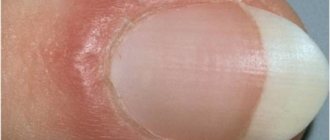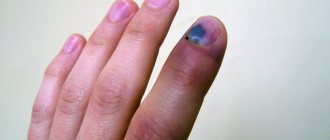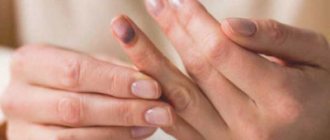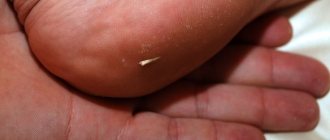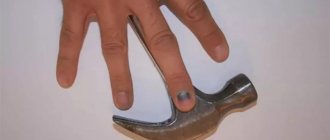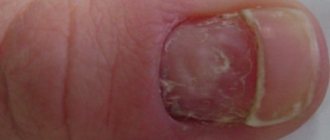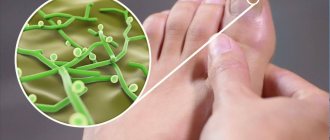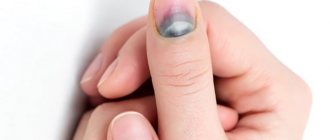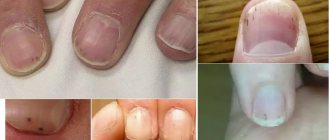Abscess on finger or panaritium is an inflammatory purulent process in the soft tissues and bones of the finger.
The main reasons for the development of felon are: abrasions, cuts on the fingers, poor-quality manicure and pedicure, ingrown nails, which contribute to the penetration of microbes deep into the skin.
Depending on what tissue and at what depth the inflammatory process occurs, panaritium can be:
- Cutaneous;
- Subcutaneous;
- Subungual;
- Articular;
- Tendinous;
- Bone.
Why does my finger itch?
There are many reasons for causing panaritium. Most often, these are microdamages to the finger from sharp objects, cuts and abrasions. Factors predisposing to the development of a finger abscess are:
- Poorly performed manicure or pedicure, when the nail cuticle is damaged or too much tissue is cut off;
- Bad habit of biting nails and skin on fingers;
- Ingrown toenails often occur on the toes. Such a nail causes inflammation of the skin on the finger, and in combination with infection - suppuration;
- Professional activities associated with frequent finger injuries or the use of chemicals;
- Pathologies of internal organs in which blood circulation in the distal parts of the arms and legs is disrupted. These are vascular insufficiency and diabetes mellitus, in which the regeneration process is poor due to various skin lesions, including on the fingers.
- Mycoses of nails and skin on the hands and feet.
The rapid development of an abscess on the finger is explained by the peculiarity of the anatomical structure of the tissues of the finger. The skin of the fingers is tightly adjacent to the bone structure due to dense connective tissue septa, which form many cells with subcutaneous fat.
Microtrauma on the skin destroys many of these cells, which leads to the rapid development of infection, since subcutaneous fat is an ideal environment for the proliferation of pathological flora. The inflammatory process on the finger does not spread over the surface of the skin, but into the deeper layers - to the bone. Therefore, the development of an abscess is accompanied by severe bursting pain.
Preventive actions
A few simple tips that, if followed, will help avoid the formation of purulent abscesses:
- Try to wash your hands as often as possible. They must be clean and dry.
- When interacting with cleaning liquids, powder or other chemicals, use gloves to protect your skin from the negative effects of chemicals.
- From an early age, wean your child from biting nails and hangnails. Such careless handling leads to the spread of infections.
- Try to do your manicure more carefully and injure your skin less. Contact only experienced specialists who use high-quality equipment and disinfect all instruments after each session.
- To avoid ingrown nails, you need to give it a rectangular shape. If the problem is hereditary, then it is better to consult a doctor who will painlessly restore the required shape and give recommendations on how to avoid recurrence of the problem.
- Even with the slightest cuts, immediately treat the wound with an antiseptic.
- If possible, the splinter must be pulled out immediately, otherwise the process of the body’s independent struggle with the foreign object may be delayed, and complications may arise.
- Do not delay going to the doctor if the inflammatory process has begun and your finger breaks out. In the early stages, treatment will not take much time, but in the later stages it will be necessary to undergo surgery.
If the affected area abscesses for more than two weeks and no folk remedy helps, you need to go to the hospital. Prolonged self-medication will increase the size of the affected area, and the infection will spread to the bones or enter the blood. It is much easier to get rid of suppuration immediately after inflammation of the skin, otherwise later it will not be possible without surgical intervention.
Symptoms and signs of felon
Common signs of an abscess on the finger:
- At the very beginning of the disease, when the process affects only the skin, redness, itching and slight soreness are noted at the site of the onset of inflammation.
- As the inflammatory process spreads deep into the tissues, the pain intensifies and becomes intense, wave-like.
- If treatment for panaritium is not started at this stage, then the inflammation spreads to muscle and bone tissue, which is accompanied by severe twitching pain, the formation of purulent discharge, increased temperature, and deterioration of the general condition.
Depending on the type of localization of felon, symptoms may have varying degrees of manifestation:
- With cutaneous and subcutaneous panaritium, an abscess is formed with redness of the skin, pain and swelling of the phalanx. The abscess breaks out without special treatment within 1-2 days.
- Periungual panaritium is often the result of a poorly performed manicure. It manifests itself as inflammation of the periungual fold, throbbing pain.
- Subungual panaritium , when an infection gets under the nail through microtrauma. The formation of an abscess is accompanied by severe throbbing pain and the discharge of pus from under the nail.
- Tendon panaritium occurs as a complication of a subcutaneous abscess. It is characterized by severe pain in the finger, severe swelling, and the inability to straighten the inflamed finger.
- Bone panaritium is characterized by intense, constant pain. The joint and phalanx of the finger are involved in the process. The symptoms are pronounced: severe throbbing pain and swelling spread to the entire hand. Finger movements are impossible due to swelling and pain. A spontaneous breakthrough of the abscess with the development of a purulent bone fistula is possible.
Alarming symptoms
The most common cause of inflammation around the nail is the use of tweezers. The infection can quickly enter microtraumas formed on the skin ridge. Unprocessed manicure tools contribute to its development.
Typically, the injured area will swell slightly a few hours after the procedure. Then, hyperemia develops and itching appears. If measures are taken at this stage, further development of inflammation can be avoided. Unfortunately, few girls pay attention to such symptoms, expecting the swelling to go away on its own. Sometimes this actually happens.
Further development of inflammation of the skin around the nail is characterized by increased swelling. The roller rises, and the pain intensifies. Gradually it acquires a pulsating character. At night, these sensations make it difficult to fall asleep. If you put a little pressure on the damaged area, the pain will become cutting.
Gradually, pus begins to accumulate under the top layer of skin. Sometimes it penetrates under the nail plate. But most often it remains under the roller and is visible through the skin.
A local increase in temperature may be observed in the affected area. The patient experiences general malaise and his lymph nodes are enlarged. Low-grade fever may also appear. In the event that the situation has gone so far, the doctor must decide how to treat the abscess on the finger.
What symptoms require immediate medical attention?
As a rule, in the initial stages of development of an abscess on the finger, patients do not rush to seek medical help. This is a completely wrong position, since felon, as mentioned above, tends to rapidly develop and penetrate into deep tissue structures. Therefore, having missed the opportunity to localize and eliminate the process at the initial stage with the help of conservative treatment, patients doom themselves to suffering and surgical treatment.
Medical help should be sought in the first two days from the onset of the first signs of development of an abscess on the finger, until the body temperature rises. Increasing, throbbing pain and increased temperature are indisputable indications for surgical treatment.
Five of the best medical remedies for abscesses for children and adults
Among the most effective and frequently used medical means in the treatment of felon are:
- Vishnevsky ointment is a time-tested remedy that gives a positive effect in the treatment of panaritium. Vishnevsky ointment is more effective if you mix it with fir oil. A mixture of these two components not only promotes faster opening of the abscess, but also cleans the wound well, being a good antiseptic. The mixture is applied to a gauze swab and applied to the abscess. The top is secured with a bandage. The tampon can be changed 2-3 times a day.
- Ichthyol ointment 10% in the form of an application on the finger. The ointment should be changed 3-4 times a day. Ichthyol ointment improves blood flow, destroys pathogenic flora and relieves inflammation.
- Levomekol in the form of an ointment is used after warming the sore finger in a hot bath for 10 minutes. The ointment effectively cleanses an opened or opened abscess from its contents, relieves inflammation and promotes regeneration of the area affected by the abscess.
- Dimexide in the form of a solution : 1 part of the substance to 4 parts of water. A gauze swab is soaked in the solution and applied to the area on the finger affected by the abscess. The finger is wrapped in plastic wrap and bandaged. This compress is left on the finger for 40 minutes.
- Levosin ointment has proven itself as an effective remedy in the treatment of panaritium caused by bacterial flora. It contains two powerful antibacterial substances - Sulfadimethoxin and Levomycetin. Cleansing and regeneration of a purulent wound occurs already on the second day after using the drug. The ointment contains a strong analgesic substance - Trimecain, which anesthetizes the finger affected by the abscess.
Treatment
Mycosis complicated by a secondary infection is the most difficult to treat. Because of the fungi themselves, the skin on the palms may peel off, peeling and disruption of the integrity of the nail plate may appear, and suppuration is the result of infection. The method of drug treatment is selected based on the severity of the affected area:
- warm hand baths. Treatment time is no more than 15 minutes. Repeats every two days. Soaking will help relieve inflammation and speed up the healing process;
- compresses applied to the sore spot.
In the early stages, these treatments should reduce pain, but if they do not help, you should consult a doctor. After examination, you will need to release the accumulated pus through surgery.
If you suffer from chronic paronychia, then most likely the cause is a fungal infection. In this case, an antifungal ointment is applied to the affected area. This procedure must be carried out daily until complete recovery. If no complication occurs, then treatment is most often more than effective. But if the condition of the abscess worsens, treatment is performed surgically. If this process is started, then the loss of the nail or the spread of infection throughout the body is possible.
For surgical intervention, it is necessary to remove purulent fluid from the wound. The process is carried out under anesthesia if the skin around the abscess is not yellow or white. In this case, anesthesia will not be required, because the nerve is damaged. The site of the abscess is trimmed and the accumulated pus is removed, after which an antiseptic compress is applied for a week. If a finger on your hand breaks out near the nail and pus has accumulated near its edge, then in this case a 1 cm incision is made and the problem area is cleaned. In some cases, the nail may be removed.
Rubber gaskets are also used, which are lubricated with Vaseline and applied to the cut part. The remaining pus is removed, and an antiseptic bandage is made on top. When the purulent discharge stops, a bandage with ointment is used instead of a rubber pad. Such methods are resorted to only in case of complications.
Five best folk recipes for an abscess on the finger
Folk remedies for abscesses on the finger have been used since ancient times and their effectiveness is undeniable. The most effective are the following remedies used in folk medicine:
- Baked onions are used as an antiseptic. A stretching and wound healing agent. A medium-sized onion is baked together with the husk until softened. The middle of the warm onion is removed and the sore finger is inserted into the resulting hole. The bulb is bandaged and kept in place for several hours. One procedure is enough to open the abscess. It is repeated to cleanse the wound.
- A long-standing folk remedy for treating felon is using laundry soap . It is grated and dissolved with boiling water until it becomes a paste. Soap ointment is applied to gauze or a gauze swab and applied to the abscess, bandaged and left overnight. The next morning, the pus from the wound is completely drawn out with soap.
- Treatment of felon with pine resin or resin . The resin is collected and applied to the inflamed finger. The resin is bandaged and left on the finger for 2 days. After removing the bandage, only a trace of the cleaned wound remains at the site of the abscess.
- An effective folk remedy in the treatment of panaritium is kerosene . The sore finger should be placed in a container of kerosene and held until a burning sensation appears. The next day after the procedure, only a wound from the abscess remains at the site of inflammation. If you hold your finger in kerosene again, the wound will quickly heal.
- Honey cakes . Take a tablespoon of flour and a small amount of liquid honey, so that when mixed they form a soft cake. It must be applied to the abscess, covered with plastic wrap on top and bandaged. Keep the compress overnight. The next morning, in place of the abscess there will only be a wound cleared of pus, which quickly heals.
Treatment tactics
Treatment depends on the type of suppuration and what symptoms accompany it. This is a general increase in temperature, symptoms of intoxication, and a history of manifestations of diabetes mellitus.
When providing first aid, it is important to prevent the development of complications. To do this, you must follow the rules:
- Under no circumstances should you open an abscess on your finger yourself. The pus must be completely removed; this is difficult to do without the help of a doctor. When puncturing, there is a risk of spreading the infection into deep-lying tissues, which will lead to a septic process.
- At the initial stage of the process, it is allowed to make baths with table salt, soap or chamomile decoction. It is recommended to steam your finger in them; the procedure is repeated several times a day. After that, thoroughly dry the limb and prevent it from becoming contaminated.
- If pus has already begun to form, a compress of aloe vera or onion can be applied to the abscess area.
In this way, the tactics for treating an abscess on the finger are formed. There are surgical methods for opening suppuration near the nail, as well as folk remedies.
If self-treatment does not give any effect for 3 or more days, you should urgently consult a doctor.
Traditional therapy
They resort to the help of doctors if the patient is not able to cure an abscess on his finger in a short time on his own. Or suffers from conditions in which tissue trophism is severely impaired:
- Diabetes.
- Immunodeficiency.
- Metabolic disorders.
- Recent infectious diseases.
- With accompanying boils in another part of the body.
- Severe vascular atherosclerosis.
Unfortunately, patients who do not suffer from concomitant pathologies usually see a doctor late, when the process has spread. It is especially dangerous when the affected area is located under the nail plate. Dense tissue does not allow pus to come out, this leads to expansion of the process and loss of the nail.
In any case, surgery is performed. Under local anesthesia, the doctor makes an incision and squeezes out all the purulent contents. The postoperative wound is washed with antiseptics and a sterile bandage is applied. Treatment of the wound and change of dressing material are carried out for several more days in a row. This is usually enough to get rid of the abscess.
Antibacterial drugs are prescribed in difficult cases, with the spread of the process and fever. A test for individual sensitivity to antibiotics is required. Self-medication without a doctor's prescription can cause enormous harm; in addition, not all drugs have an effect; they can also cause dysbacteriosis.
If a patient has an abscess on his toe, it makes sense to prescribe a short course of antifungal medications after surgery. The foot and toes are extremely vulnerable to the penetration of fungi; this situation must be foreseen.
Unconventional treatment for abscess on a finger
- Make a dressing from mashed baked onions and crushed laundry soap. Mix the ingredients equally, apply to the wound and wrap with a sterile bandage. Change the bandage every 3-4 hours.
- From the very beginning of the disease, take a glass of warm boiled water, add 10 drops of iodine, 1 tbsp. l. salt and soda. Keep your finger in the resulting liquid for 15-20 minutes.
- To eliminate an abscess near the nail, take equal parts of carrots, onions, beets, and a few drops of aloe. Grate on a fine grater or pass through a blender. Mix thoroughly and make a compress.
- Heat 50 grams of honey and ground laundry soap in a water bath, mix, add flour. Make a cake from the resulting mass and apply to the affected area.
- A poorly done manicure can cause problems. If your finger is narwhal, a mixture of chamomile, calendula and string will help. Immerse your finger in the resulting herbal mixture for at least 20 minutes. Repeat the procedure several times with an interval of 3 hours.
- Grate a raw potato tuber, apply and bandage. It has a pronounced analgesic effect and cleanses wounds.
- If there is an abscess under the fingernail, nettle tincture will be effective. To prepare it, you will need to make a composition: pour young nettle leaves with vodka, leave for 2 weeks in a well-lit place. Moisten sterile gauze in the resulting composition, apply to the suppuration and wrap with polyethylene. Within a short time, a breakthrough of pus should occur.
Knowing how to remove pus in the area of fingers and toes, you can avoid dangerous complications. The same applies to childhood. Children are prone to injuries due to improper nail cutting and neglect of hygiene. It is difficult to rid a child of an abscess on his finger on his own and you may miss the moment of general infection. It is better to consult a doctor immediately. After examination by a doctor and by agreement, you can try using folk remedies. They are not much different from measures for adults, only they are used in a more gentle form.
For abscesses before surgery, Vishnevsky ointment and Levomekol help well.
Apply the ointment to the skin at the affected area, be sure to remove any excess. You need to put a bandage on top. If the circumstances are successful, no additional manipulations with the child’s hands will be necessary. Understanding how to get rid of pus in the skin of the fingers using folk and traditional methods, everyone will be able to choose a method of treating an abscess on the finger for themselves. The main thing is to understand that delay is dangerous and if the condition worsens, you should immediately contact a specialist. Only he can give the right advice on how to cure a boil, what to do if your finger breaks out further.
Children and adults experience abscesses on the fingers near the nail
. Hands come into contact with water and different things every day. The skin on the hands is thickened, and the fingers on the outer phalanges are protected by dense nail plates. But it is very difficult to completely eliminate injury to the skin of the hands.
Pathogenic microbes easily enter the skin through small, unnoticeable scratches. After some time, a certain area becomes inflamed and suppuration appears.
You should not ignore such a problem as an abscess on your finger near the nail; folk remedies will tell you what to do.
There are many proven recipes that will help you quickly eliminate this disease at home.
.
An acute inflammatory process on the finger near the nail is medically called paronychia
.
If a person has a weak immune system, then when the skin is damaged, staphylococci, fungi, and streptococci enter the tissues of the fingers. They cause a purulent inflammatory process.
Provoking factors:
- fungal diseases on the fingernails;
- unsuccessful manicure;
- cuts near the nail fold;
- poor circulation inside the veins;
- ingrown nail;
- consequences of diabetes.
Whatever the cause of paronychia, it will be characterized by the following symptoms:
- Redness of the skin on the problem finger.
- Unexpressed pain during the formation of edema.
- Detection of pus in the affected area.
- Gradual increase in edema and phalanx.
- Increasing pain of a pulsating nature.
- Limitation of finger movement, sensation of warmth around it.
- Deterioration in health: fatigue, headache, increased body temperature.
Diagnosing paronychia is not difficult at all, even for those who do not have deep knowledge in the field of medicine. Signs of an abscess on the phalanx appear quite clearly. And it’s difficult to confuse an abscess with something else; it matures intensively.
In some cases, when contacting a specialist, an x-ray of the limb may be prescribed. This will make it possible to identify the severity of the disease and the possibility of complications.
An abscess in advanced form is very dangerous
. The finger may completely or partially lose its function if the purulent inflammatory process spreads to the tendons, bone tissue, or joint of the finger. In severe cases, the hand and forearm may be affected.
If you have diabetes, the following complications may occur:
- Sepsis
is a very dangerous condition; without qualified timely assistance it can lead to death. - Phlegmon of the hand
is an acute purulent inflammation of the cellular tissue of the hand. - Tenosynovitis
is a purulent inflammatory process in the tendons. This condition causes long-term loss of movement in the affected finger. - Osteomyelitis
- this complication causes damage to bone tissue by pus. If surgical intervention is not done in a timely manner, complete amputation of the finger may be necessary.
How is an abscess treated in a hospital? When should you open an abscess?
At the beginning of the process, when the inflammatory process is just developing, conservative antibacterial therapy is used. In addition to antibiotics in the form of tablets or intramuscular injections, baths with hypertonic solution and physiotherapy are used.
But as soon as the purulent process begins, which can be identified by redness and swelling on the finger, as well as severe throbbing pain and fever, you must not delay a visit to the surgeon.
- Skin felon is treated by excision of the epidermal bladder at the border with healthy skin and treatment with 3% hydrogen peroxide and brilliant green.
- A more complex procedure is performed for periungual or subungual panaritium. In this case, not only the abscess is opened, but also part of the nail damaged by the purulent process is removed.
- With subcutaneous panaritium, lateral incisions are made on the finger, through which drainage is carried out, which is necessary for a more effective outflow of pus.
- Bone and articular panaritium are treated in a surgical hospital according to an individual scheme.
For severe throbbing pain with the development of an abscess, painkillers are used - Paracetamol, Analgin and other drugs in the form of tablets or injections.
Dioxidin for inflammation of the finger
Panaritium is an infectious inflammatory process in the epithelial tissues of the inner surface of the palms (less often the feet), as well as the periungual space.
The reason for the development of pathology is the proliferation of pathogenic bacteria in the epithelial tissues, which cause the death of cells in this area, which is why the patient develops large pustules filled with pus.
The classification of felon is based on the location of the source of infection and inflammation.
The symptoms of panaritium are difficult to miss, since gradually without proper treatment the inflammatory process intensifies, the skin in places becomes very red, the pathology is accompanied by pain and the appearance of purulent rashes.
Treatment of felon should be carried out by a professional; no home methods will help eliminate the source of infection, they can only aggravate the situation.
For therapy, external agents with a disinfecting, pus-pulling and anti-inflammatory effect are used; less often, the patient is prescribed internal antibiotics or surgery.
Without timely treatment, felon can cause serious complications, including sepsis and tissue necrosis.
Complications and prevention of panaritium
Panaritium in an advanced stage is dangerous due to serious complications:
- Diffuse spread of a purulent process with the development of phlegmon;
- Total damage to all structures of the phalanx, which leads to its dysfunction;
- Development of sepsis (when blood is infected with purulent microflora);
- Development of necrosis of blood vessels of the finger;
- Osteomyelitis.
In more severe cases, the purulent process can spread to the hand and forearm. Therefore, it is important to prevent microtrauma of the fingers and toes. But if an injury occurs, then it is necessary to properly treat it and apply an aseptic bandage to the wound.
DIOXIDINE
Antibacterial drug, quinoxaline derivative
Active substance
– hydroxymethylhinoxalindioxide
Release form, composition and packaging
Solution for intravenous administration
light yellow with a greenish tint, transparent.
| 1 ml | 1 amp. | |
| hydroxymethylquinoxaline dioxide | 5 mg | 50 mg |
Excipients: water for injection.
10 ml – ampoules (10) – cardboard boxes.
Indications
- purulent bacterial infections caused by sensitive microflora when other chemotherapeutic agents are ineffective or poorly tolerated;
- severe septic conditions (including in patients with burn disease);
- purulent meningitis;
- severe purulent-inflammatory processes with symptoms of generalized infection.
Dosage
A 0.5% solution of the drug is administered intravenously, which is diluted with a 5% dextrose solution or 0.9% isotonic sodium chloride solution to a concentration of 0.1-0.2%. The daily dose of the drug is administered once or in 3-4 doses (fractional administration). The drug is administered at a rate of 60-80 drops/min for 30 minutes.
Recommended doses of the drug depending on the location of the process.
In the treatment of purulent urinary tract infection
daily dose – 200-400 mg of dioxidine, i.e. 40-80 ml of 0.5% solution;
For chronic purulent processes in the lungs
– daily dose of 500-600 mg of dioxidine, i.e. 100-120 ml of 0.5% solution.
For purulent meningitis
daily dose – 600-700 mg of dioxidine, i.e. 120-140 ml of 0.5% solution.
For severe septic conditions
A 0.5% solution of the drug is administered intravenously, which is diluted in a 5% dextrose solution or 0.9% isotonic sodium chloride solution to a concentration of 0.1-0.2%. Daily dose 600-900 mg (in 3-4 doses).
With intravenous administration, headaches, chills, fever, dyspeptic disorders, muscle contractions, allergic reactions, and a photosensitizing effect (the appearance of pigmented spots on the body when exposed to sunlight) are possible.
Pregnancy and lactation
Contraindicated during pregnancy and lactation.
For impaired renal function
Carefully _
– renal failure. In case of chronic renal failure, the dose is reduced.
Conditions for dispensing from pharmacies
The drug is available with a prescription.
